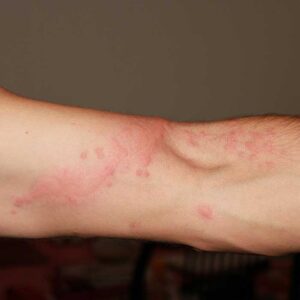What are jellyfish stings?
Speaking of a jellyfish sting isn’t technically correct, as jellyfish don’t have stingers. Instead, it is the cells in their tentacles that sting. Jellyfish tentacles are both defensive tools and powerful weapons, and are lined with special cnidocyte cells which inject a stinging liquid into a jellyfish’s prey. The liquid released during jellyfish stings often consists of a mixture of three key proteins with the following properties:
- paralysing,
- inflammatory,
- neurotoxic
Jellyfish sting is represented by the reaction of our skin once we come in contact with the liquid released by their tentacles. To speak of jellyfish stings is actually not quite correct. Jellyfish, in fact, do not have a stinger but turn out to be extremely stinging through their tentacles.
What are the consequences of a jellyfish sting?
As soon as contact between the skin and the jellyfish occurs, the affected area will become extremely painful, with an intense burning sensation. Soon after, the skin becomes inflamed and small, hive-like bumps appear. The burning sensation ends between ten and twenty minutes after contact, and there follows intense itchiness. In some cases, contact with a jellyfish tentacle causes blisters to appear as if it were a burn. The degree of pain and burning depends on the area(s) of skin affected. Such reactions can become unbearable if more than 50% of the body surface is affected.

In recent years, it has become increasingly common to cross paths with jellyfish during the summer season. It is sometimes even possible to see smacks of jellyfish covering the coastline just a few meters from the shore where people are swimming. According to experts, this phenomenon is mainly due to rising temperatures. In the past 20 years, the Mediterranean Sea has warmed by around 5°C, making it an increasingly comfortable habitat for jellyfish.
There are many different types of jellyfish and most are harmless. Indeed, jellyfish do not set out to attack humans but will sting anyone or anything that unknowingly bumps into them. The most dangerous types of jellyfish are:
- The Mauve Stinger (pelagia noctiluca): very common and purplish in color
- Portuguese Man o’ War (physalia physalis): rare and with a recognizable sail shape.
- Box Jellyfish: recognizable by its distinctive cubic shape. Some types of box jellyfish are known as ‘sea wasps’.
- Compass jellyfish (chrysaora hysoscella): known for the beautiful markings covering the fringe and bell.
- Pink Meanie (drymonema): very rare; known for its considerable size and weight.
How to treat a jellyfish sting
If a jellyfish sting occurs and there is no immediate way of dressing it properly, the best thing to do is rinse the sting with seawater, which can dilute toxins that have not yet penetrated the skin. Apply Astringent Gel to the affected area(s) as soon as possible after contact. Thanks to aluminum chloride, Astringent Gel is antipruritic and blocks the spread of toxins from jellyfish stings.
Treatment
- Apply Astringent Gel to the affected area(s) as soon as possible after contact and re-apply every 15 minutes until all itching and/or burning sensations have subsided.
In the days following a sting, skin may remain inflamed and could blister and/or scab. In persistent pigmentation, apply PEG Balm to the affected area and protect the skin from the sun with clothing or dressings.
- Do not rub sand or hot stone on the skin. Jellyfish toxins are thermolabile, which means they can be deactivated under heat. However, in order to deactivate the toxins, temperatures must hit between 60℃ or 70℃ which is too high and puts the skin at severe risk of burning.
- Do not apply ice to the sting as the cold can preserve or even enhance toxins.
- Do not scratch the sting. While instinctive, it is important not to scratch, as the added pressure on the area can cause the release of more venom.
In the days following a sting, do not expose the affected area to the sun. Do not apply sunscreen to the sting as the skin will become more inflamed. The redness turns into persistent pigmentation.
Remedies such as applying urine, ammonia or alcohol to the area should be ignored, because they make the sting worse and may even spread the stinging cells over a larger area.













